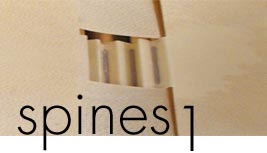
SPINES 1
The spine is of primary importance for books, just as it is for human beings. We talk about good opening and flexibility as opposed to the stiffness of some volumes that can hardly be read. And when a book cannot be read...can we call it a book?
Working advice: The measurements given in this description are generic and you should make your own. Click here to see the images.
PERGAMO
This is a binding I have devised for a samples book of decorated papers that needed to open flat (see 'Samples Books' in this site). The name Pergamo comes from the fact that my first binding of this sort was made in parchment (pergamino in my native language) and its spine looks very much like a marble column of the old city*.
It is a very light structure that can be made in heavy paper or vellum. Its longstitch sewing is protected by the spine folds (see images 1 and 2).
How to make it
Take a piece of heavy paper or parchment four times the width of the book-block plus three times the thickness of the spine. Cut the height 1-2mm bigger than the book-block.
With a bonefolder make a vertical line in the centre of the covering material and add parallel lines on both sides keeping the same distance between them. You will need two lines for each section of the book plus one (for example: for a five sections book-block you must have 11 lines at the spine).
The distance between the lines depends on the size of the book, the material you are using and the thickness of the sections. This is a delicate operation that requires attention, as the distance between the lines should be exactly the same.
When the scoring of the lines is finished do not fold the concertina.
Divide the length of the spine into five panels and mark the divisions with a pencil; at each of the resulting four marks make a horizontal cut across the spine, going from the first to the last vertical lines.
Then make a vertical cut over the central line of the second and fourth panels. The two flaps resulting from this cut must be folded inwards at the spine's edges. They will be used later to fix the double cover (see image 3).
I have divided the spine into five panels but the vertical division is up to you.
Preparation for sewing
Fold the spine lines of panels one, three and five into three concertinas, decide the position of the sewing stations and make the holes in the inner folds with a needle or a thin awl.
Measure the distances between the sewing stations and transfer them to the sections. Make sure everything is in place and pierce the holes in the folds with a needle or an awl.
Before sewing prepare the two structural labels that will cover the "windows" at the spine and at the same time prevent the concertina from expanding to its full extent (see image 4). To make the labels you can use the same material of the cover or one with a different texture or a different colour.
The two labels have the shape of a fat H: the horizontal stroke will cover the spine windows and must be the height of the windows and the width of the spine.
The labels can have a title and the author's name. The sides of the H are higher than the spine windows and once the sewing is finished they prevent the label from coming out. Their size depends very much on the size of the book and of the importance you want to give them as decoration. When the book is sewn these inner extensions will lay over the endpapers (see image 3).
The sewing
The H-shaped label must be inserted between the cover and the sections right from the beginning, which makes the sewing a bit tricky. Each section is sewn separately. See sewing 5 in CSB sewings on this site.
After sewing
Once the sewing is made the cover is folded inwards at the fore-edge (the size of the squares depends on the size of the book) and the exceeding covering material is cut out (see image 4).
Fix the four spine flaps to the inner cover. The flaps can be hidden under the cover or remain on sight and can either be sewn or glued to it.
* Pergamon or Pergamo was an ancient Greek city in modern-day Turkey, that became the capital of the Kingdom of Pergamon during the Hellenistic period, under the Attalid dynasty, 281-133 BC.